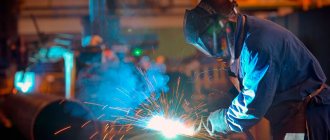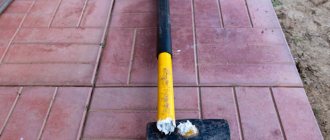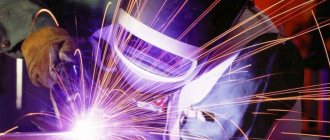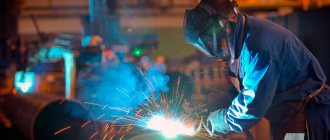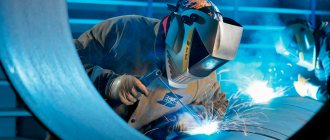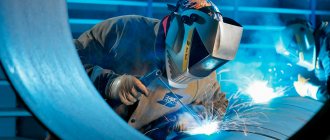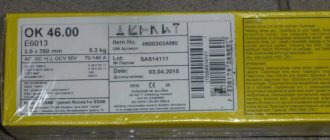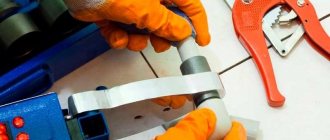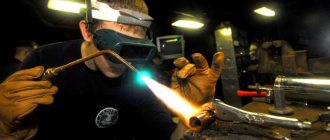The New Year 2022 brought many surprises to occupational safety specialists.
So, about forty not-so-old labor safety rules were canceled at once. On January 1, 2022, new rules on labor protection when performing electric welding and gas welding work, approved by Order of the Ministry of Labor of Russia dated December 11, 2020 No. 884n, came into force. They will be valid for five years - until December 31, 2025. Article navigation
- New in the rules on labor protection when performing electric welding and gas welding work: 14 changes
- What should an occupational safety specialist take into account when working under the new rules?
Why is it important to follow labor safety rules in the welding area?
Welding work is considered dangerous and harmful for a reason. At welding sites, potential hazards are everywhere. These may be dangerous flammable substances, high temperatures of objects, flammable and explosive substances, or a fire. Therefore, labor protection during welding work plays a key role.
Safety rules and regulations for welding activities are established by adopting a local regulatory legal act at the enterprise or organization - the Labor Safety Instructions (hereinafter referred to as the Instructions). Depending on the specifics of the enterprise’s activities, there may be one general security instruction. If an enterprise has significant production volumes and combines several areas of activity, then there may be several instructions on labor protection, each for a separate area.
To be allowed into the site, an employee must
- Meet all statutory qualification requirements.
- Complete initial and introductory safety training and other necessary types of training.
- Have sufficient skills in handling welding equipment, use it only for its intended purpose and with the knowledge of management.
- Use personal protective equipment and keep it clean and in proper shape. It is not allowed to wear a jacket with an open collar, roll up the sleeves, or weld in oily clothing or mittens.
- Be able to provide first aid to injured colleagues and other people until the medical team arrives.
- Know how to use fire-fighting equipment in the event of a fire for its intended purpose. Know the signals of fire safety devices, ensure free access to fire safety equipment and emergency exits.
- If you feel unwell or feel unwell, stop working, consult a doctor, and immediately inform your immediate supervisor. If your colleagues are not feeling well, you should immediately inform the doctors, provide first aid if necessary, and inform management. The employee must know the location of the first aid kit, know its contents and be able to use it in practice.
- Clean the welding machine at least once a month.
- Ensure that at the welding site there is a special partition made of fireproof material with a height of at least two meters, the distance between the floor and the walls must be at least 50 mm.
- In the event of a technical malfunction of equipment or wiring, immediately inform your immediate supervisor.
- Comply with internal labor regulations.
- Ground the electric welding installation.
- Install identification marks for the welding location or mark them in another visible way.
- Degrease surfaces with special non-flammable solutions. Do not use kerosene, gasoline or other flammable substances.
- Do not use equipment whose operating instructions are not familiar to you.
- Maintain rules for storing hazardous substances.
- Maintain cleanliness and order in the welding area during all working hours, do not clutter the workplace with garbage and waste.
- Undergo a medical examination in accordance with the established procedure.
- Carry out only the assigned task, do not allow arbitrary operation of the equipment.
- Do not use faulty equipment.
- Operate devices in a safe manner.
- Transport gas cylinders only on special carts, avoiding sudden shocks.
- Is sober at work. If you identify colleagues, people in a state of alcoholic, drug or toxic intoxication, or drinking alcoholic beverages, immediately stop them from performing work, ensure their removal from the work site and report to superiors.
- Do not eat food at your workplace.
- Bear responsibility for failure to comply with safety regulations (disciplinary, civil, administrative, criminal).
General provisions
1.1. Persons who have reached the age of 18, are recognized as suitable for this work by a medical commission, have undergone special training in safe methods and techniques of work, and have a qualification group in electrical safety of at least II are allowed to perform electric welding work.
1.2. A manual electric welder who is hired must undergo an introductory briefing on labor protection, industrial sanitation, fire safety, techniques and methods of providing first-aid to victims, must be familiarized with the working conditions, rights and benefits for working in harmful and dangerous conditions. labor, on rules of conduct in case of accidents.
1.3. Before starting work directly at the workplace, a manual electric welder must undergo initial instruction on safe methods of performing work.
About the conduct of introductory briefings and briefings at the workplace, appropriate entries are made in the Logbook for registration of introductory briefings on labor protection issues and the Logbook for registration of briefings on labor safety issues.
In this case, the signatures of both the one who was instructed and the one who instructed are required.
1.4. An electric welder who is hired, after initial instruction, must undergo an internship for 2-15 shifts (depending on length of service, experience and the nature of the work) under the guidance of an experienced qualified electric welder for manual welding, who is appointed by order (instruction) of the enterprise.
1.5. The electric welder must undergo repeated instruction on the rules and techniques for safe work:
– periodically, at least once a quarter;
– with unsatisfactory knowledge of labor protection no later than one month;
– in connection with an incident of injury or violation of labor protection requirements that did not lead to injury.
1.6. A manual electric welder must work in special clothing and special footwear provided for by the Standard Industry Standards: a canvas suit or suit for a welder, canvas gloves, leather boots.
On external robots in winter: cotton jacket and trousers with insulated padding, felt boots.
1.7. Workplaces must be provided with inventory barriers, protective and safety devices, and have sufficient lighting. If necessary, use a serviceable portable lamp with a voltage no higher than 42 V, and when working in boilers, tanks, wells - no higher than 12 V.
The illumination of the workplace must be at least 50 lux.
1.8. The electric welder must keep the workplace tidy and clean throughout the working day, and not block the passages to it with materials and structures.
1.9. It is prohibited to carry out external electric welding work on scaffolds during a thunderstorm, ice, fog, or with a wind force of 15 m/sec or more.
1.10. Place the electric welding installation so that free access to it, convenience and safety during work are ensured.
When using several welding installations simultaneously, they must be installed no closer than 350 mm from one another, and the width of the passages between them must be at least 800 mm.
1.11. The electric welding installation must be connected to the mains only using a starting device.
It is prohibited to feed the welding arc directly from power and lighting electrical networks.
The length of the wires between the power supply network and the mobile unit should not exceed 10 m.
The cable (electrical wiring) should be placed at a distance of at least 1 m from the oxygen and acetylene pipelines.
1.12. The distance from the place where electric welding work is carried out to the place where the gas generator, gas cylinders and flammable materials are installed must be at least 10 m.
1.13. It is prohibited to store flammable materials and explosive substances in welding rooms.
1.14. In enclosed spaces and inside containers, the electric welder must work with supply and exhaust ventilation.
The simultaneous work of an electric welder and a gas welder (gas cutter) inside a closed container or reservoir is prohibited.
1.15. Workplaces when several electric welders are working in one room should be fenced with light-proof shields (screens) made of fire-resistant material with a height of at least 1.8 m.
1.16. Carrying out electric welding work at height from scaffolding and other means of lifting is permitted only after the foreman has checked their strength and stability, as well as after taking measures to prevent the decking from catching fire, the fall of molten metal and electrode stubs on workers or people passing nearby.
The use of random supports is prohibited.
1.17. The electric welder, if necessary, must descend into trenches (pits) using stepladders and cross ditches and trenches using transition bridges.
1.18. The electrode holder must be factory-made, lightweight, provide reliable clamping and quick change of electrodes without touching conductive parts, and be in good working order.
The handle must be made of heat-insulating dielectric material. It is prohibited to use electrode holders with a lead wire to the handle at a current strength of 600 A or more, as well as hand tools that have:
– potholes, splitting of working ends;
– hangnails and sharp ribs in places where the hand is pinched;
– cracks and chips on the back of the head.
1.19. Do not wipe parts with gasoline or kerosene before welding.
1.20. It is necessary to ensure that hands, shoes and clothes are always dry.
2. Safety requirements before starting work
2.1. Before starting work, the electric welder must:
2.1.1. Put on overalls, safety shoes, and fasten the sleeve cuffs. In this case, the jacket should not be tucked into the trousers, and the trousers should be pulled out over the boots.
2.1.2. Obtain personal protective equipment that must be used as intended:
— electric welder’s shield – for protection from splashes of molten metal, from the effects of electric arc rays;
— warning belt – when working at height, inside a container;
- hose gas mask - for working inside closed containers in the presence of aerosol, gas, dust;
- a helmet with two- and three-layer liners - to protect the head from falling objects;
- asbestos and canvas sleeves - for protection against splashes of molten metal during ceiling welding;
— safety glasses with light filter grades “B”, “G”.
2.1.3. Inspect and organize the workplace and the passages near it; the floor in the workplace must be dry.
2.1.4. Check the insulation of the welding wires, make sure that the electric welding installation is grounded and that all contacts are securely connected.
2.1.5. Make sure that there are no flammable or combustible materials near the welding site.
2.2. It is prohibited to carry out welding work in pressure vessels.
2.3. Before welding begins, parts (structures) must be securely fastened.
2.4. It is prohibited to leave the electrode holder unattended under voltage, or to work when the welding machine, welding wires, electrode holder or helmet-mask (shield) are faulty.
3. Safety requirements during work
3.1. Work in closed containers must be carried out by at least two workers, one of whom must be outside the welding container to monitor the safe performance of work by the welder. This worker must have a qualification group of at least III for this type of work.
An electric welder who works in the middle of a tank must have a warning belt with a rope attached to it, the second end of which, at least 2 m long, must be in the hands of another worker located outside the tank.
Portable lighting in the middle of the container should have a voltage of no more than 12 V.
When welding in the middle of boilers and tanks, the electric welder, in addition to special clothing, is required to use dielectric gloves, galoshes, carpets, and a helmet to protect the head.
3.2. When carrying out electric welding work at height, the electric welder must use a bag for electrodes and a box for cinders.
It is prohibited to scatter cinders.
3.3. The welding machine must be connected to the power supply through an individual switch using a wire of the appropriate cross-section in accordance with the operating instructions for the welding machines. In this case, the distance between the welding machine and the wall must be at least 0.5 m.
Only electricians should connect and disconnect electric welding installations from the electrical network, as well as repair them. Electric welders are prohibited from performing these operations.
3.4. Work in particularly hazardous areas must be carried out only after receiving a work permit, if the device has an electrical lock that ensures automatic shutdown of the welding circuit when replacing the electrode during idle operation.
3.5. When welding on ceilings, it is necessary to use asbestos or canvas oversleeves; when welding non-ferrous metals and alloys that contain zinc, copper, lead - respirators with a chemical filter and carry out work only with local suction running.
3.6. Prohibited:
– cutting and welding metal by weight;
– carry out welding work from stepladders.
3.7. When performing welding work, it is necessary to cover your face with a shield with light filters to protect your eyes and face from the rays of an electric arc, as well as splashes of molten metal.
3.8. When carrying out electric welding work directly on a car, the electric welder must first ground the frame or body of the car. If welding is carried out directly near the fuel tank, cover it with a sheet of iron or asbestos to prevent sparks.
3.9. Before carrying out welding work on a gas-cylinder (gas-diesel) car, the gas must be released, and the cylinders must be purged with inert gas and the foreman must be informed about this.
3.10. Welding when repairing containers for fuels and lubricants should be carried out after treating them with a 15-20% solution of caustic soda or blowing with dry steam, followed by checking the contents of hazardous substances in the containers using a gas analyzer.
Welding should be carried out with the covers open.
3.11. An electric welder is prohibited from:
– look for yourself and allow others to look at the electric welding arc without protective glasses or shields;
– work with a shield, glasses that have gaps and cracks;
– work on electrical equipment with exposed wires and exposed conductive parts;
– connect several electric welding units in series to the grounding conductor.
3.12. The welding unit should be grounded before connecting it to the electrical network.
Metal parts of welding installations that are not live during operation must be grounded.
Above the terminals of welding transformers there should be visors and inscriptions: “High side”, “Low side”.
3.13. It is prohibited to block access and passages to fire-fighting equipment, fire extinguishers and hydrants.
3.14. Welding installations must be disconnected from the network while they are moving.
3.15. The use of electric welding wires with damaged braiding or insulation is prohibited.
The cores of the welding wires should be connected by crimping, welding, soldering or special clamps (with a mandatory power outage).
3.16. It is prohibited to use the grounding loop of sanitary network pipes (water supply, gas pipeline, etc.), metal structures of buildings and technological equipment as a return wire.
3.17. The open-circuit voltage of welding power sources should not exceed the maximum values specified in the welding equipment passport.
3.18. The electric welder must immediately report all cases of broken wires, malfunction of grounding devices and other damage to electrical equipment to the foreman.
4. Safety requirements after completion of work
4.1. Upon completion of work, the electric welder must:
– disconnect the electric welding installation from power sources;
– turn off the ventilation.
4.2. Put your workplace, equipment, tools and devices in order.
Put the wires and tools in the designated place or put them in the storeroom.
4.3. Take off overalls and safety shoes, clean them of dust and other dirt and put them in the designated place for storage and change clothes. Then wash your face and hands with warm water and soap or take a shower.
4.4. Inform the foreman about the completion of the work and about any problems during the work.
What hazards exist on the site?
- Splashes of molten metal flying off during welding. Hot pieces can get into exposed areas of the body and eyes. If welding is carried out at a certain height, then splashes and sparks fly down, break into oncoming objects, and scatter in large diameters. Therefore, everyone needs to use only special clothing and shoes, protective shields, glasses, gloves, an apron, and at the construction site - a safety helmet.
- High temperature of the arc (about 4000 degrees), gas cutter, and other objects. The danger comes from things heated to a high temperature, which may outwardly appear cold.
- Harmful gases and aerosols. Welding aerosols are mixtures of various chemicals released during the welding process. The composition of the mixtures varies depending on the type and method of welding. The most harmful are zinc, chromium, silicon, and nitric oxide. Aerosols can cause poisoning, so welding areas must be well ventilated, and the welder must wear a special protective mask or respirator.
- Ultraviolet, visible and infrared radiation can cause skin burns of varying severity and eye inflammation.
- Uneven surfaces of various objects and workpieces, sharp burrs, roughness.
- High voltage electric current in the circuit.
- Poor or non-functional ventilation.
- Large accumulation of toxic dust released during welding. Manganese oxides, chromium and silicon compounds can cause damage to the nervous system, liver, blood and lungs.
- Intense noise when using plasma arc cutting.
- Radiant energy from arc welding is visible light radiation that can cause severe pain and tears in unprotected eyes.
- Possibility of injury from interacting with equipment.
- Insufficient or, on the contrary, too bright illumination.
- Explosion hazard.
- Welding at height.
- Mental overload.
Means of protection
Strict requirements are placed on welder protective equipment. It must reliably protect against electric arcs and metal scale. Protective clothing is made of special non-flammable fabric:
- thick skin;
- tarpaulin;
- special cloth;
- split wood;
- canvas impregnated with a fire-resistant compound.
The protection kit includes a suit, safety shoes, helmet and mask, and leggings.
Before starting the working day, clothing should be checked for contamination with oil or other industrial lubricants. Shoes should have thick soles to prevent the passage of current. It must not have metal plates or nails on it. There should be a thick insert inside the sock to protect your toes from heavy objects.
Leggings come in different varieties and are selected depending on the type of welding work. There are two-, three- and five-fingered models; without cuffs or, conversely, with high sides that protect the arms up to the elbows. For some types of work (for example, gas welding), it is permissible to use oversleeves and aprons instead of special suits.
Defects in the mask are not allowed. It must not only be in full working order, but also selected in size and tightly attached to the head. There is a wide range of masks available on the consumer market, including those with artificial inflation, adjustable filters, etc. The filter must protect the eyes well and at the same time provide a good enough view to control the work process.
Labor protection requirements before welding work
The welder is obliged:
- Receive an order to perform a specific welding task.
- Provide yourself with personal and collective protective equipment and check their serviceability.
- Wear clean, oil-free special clothing and shoes, avoiding exposed areas of the body and hair.
- Check the workplace directly: clean it of dust, dirt and debris. Do not block exits with debris. The floor at the welder's workplace must be clean and dry.
- Make sure that there are no gas cylinders, unwashed containers of already used flammable materials, paint, or other flammable substances nearby. If there are any, then you need to ensure that they are at least 10 meters away from the workplace.
- Make sure that the welding machine is in good working order, that the grounding is reliable, that the electrical wiring is properly insulated, that the welding circuit is intact, and that the starting device is in good working order.
- Check the reliability of fixation of the elements to be welded.
- Turn on ventilation
- Provide a partition or special protective screen.
- Clean the edges from slag and rust.
- Ensure proper functioning of the welding unit.
- Use mats that protect against moisture when welding fixed pipe joints.
- Check the presence of water, sand or a fire extinguisher at the work site.
- If tanks containing flammable substances are to be welded, they must be thoroughly washed and dried.
- If welding of car frame elements is to be done, then the body must be grounded and the fuel tank must be removed.
- The generator should be placed in a warm place if the temperature is below zero.
General requirements
1. Persons who have reached the age of 18, are recognized as fit for this work by a medical commission, have undergone special training in safe methods and techniques for performing work, have been given instructions on labor safety and tested their knowledge of electrical safety, and have a qualification certificate are allowed to perform electric welding work.
2. Anyone entering work must undergo introductory training on labor safety, industrial sanitation, provision of first aid, fire safety, environmental requirements, working conditions and initial training at the workplace, about which entries must be made in the appropriate journals with the obligatory signature of the person being instructed and the person instructing . Every year, the electric welder must be tested on his knowledge of safety requirements with proper documentation of protocols.
3. Women are not allowed to carry out electric welding work inside containers (boilers, tanks, tanks).
4. The welder is obliged to perform only the work that is permitted by the administration, and provided that the safe methods of performing it are known to him, and have at least II qualification group in safety.
5. Workplaces are provided with tested inventory fences, protective and safety devices, devices, and must have sufficient lighting. If necessary, use a serviceable portable lamp with a voltage not exceeding 42 V, and when working in boilers, tanks, wells, etc. - no higher than 12 V.
6. The electric welder must keep the workplace tidy and clean throughout the working day, and not block it and the passages to it with materials and structures.
7. When working at height, he must use a proven safety belt.
8. It is prohibited to carry out external electric welding work on scaffolding during a thunderstorm, ice, fog, or with a wind force of 15 m/sec or more.
9. Place the electric welding installation so that free access to it, convenience and safety during work are ensured.
When several welding installations are operating simultaneously, they should be placed at a distance of at least 0.35 m from one another.
10. Connect the electric welding installation to the electrical network only using a starting device.
It is prohibited to feed the welding arc directly from power and lighting electrical networks.
The length of the wires between the power supply network and the mobile unit should not exceed 10 m.
The cable (electrical wiring) should be located at a distance of at least 1 m from the oxygen and acetylene pipelines.
11. The distance from the place of electric welding work to the installation site of the gas generator, gas cylinders and flammable materials must be at least 10 m.
12. It is prohibited to store flammable materials and explosive substances in welding rooms.
13. In enclosed spaces and inside containers, the electric welder must work with supply and exhaust ventilation.
The simultaneous work of an electric welder and a gas welder (gas cutter) inside a closed container or reservoir is prohibited.
14. Workplaces when several electric welders are working in one room or on large-sized parts should be fenced with light-proof shields (screens) made of fireproof material with a height of at least 1.8 m.
15. Electric welding work at a height of more than 1 m should be carried out only from fenced scaffolding or scaffolding with the permission of the foreman (foreman).
It is prohibited to use unreliable, random supports for scaffolding.
16. You should go down into trenches (pits) using stepladders or ladders, cross ditches and trenches using transition bridges.
17. Inventory lamps for illuminating the workplace should be installed so that there is no glare from the light flux.
18. The electric welder must receive individual safety devices, the use of which is permitted only after special instructions:
- electric welder's shield - for protection from splashes of molten metal, from the effects of electric arc rays;
— safety belt — when working at height, inside a container;
- hose gas mask or breathing machine - for working inside closed containers in the presence of aerosol, gas, dust;
- a helmet with two- and three-layer liners - to protect the head from falling objects;
- dielectric gloves, galoshes and a mat - for working with power tools in damp areas;
- asbestos and canvas sleeves - for protection against splashes of molten metal during ceiling welding;
— safety glasses with light filters grades “V”, “G” (GOST 12.4.013-85).
19. The electric holder must be factory-made, lightweight, provide reliable clamping and quick change of electrodes without touching live parts, and have a visor that protects the welder’s hand.
The handle must be made of heat-insulating dielectric material. It is prohibited to use electric holders with a lead wire in the handle at a current strength of 600 A or more, as well as hand tools that have:
— potholes, chipped working ends;
— burrs and sharp edges in places where the hand is pinched;
— cracks and chips on the back of the head.
20. Do not wipe parts with gasoline, kerosene, etc. immediately before welding.
21. It is necessary to ensure that hands, shoes and clothes are always dry.
22. Only a trained electric welder who has the appropriate certificate can operate hand-held mechanized tools, as well as engage lifted materials with lifting mechanisms.
Requirements for labor protection during welding work
- It is not allowed to place flammable substances near the welder’s workplace. Materials subject to combustion must be within five meters of the workplace, explosive, flammable substances - no closer than ten meters.
- The welder cannot repair or turn equipment on or off. This is entrusted to electricians. The welder only monitors the serviceability of the device.
- Gas cylinders should not be located closer than five meters from heat sources.
- The welder carries out work outdoors during rain or snow only under special fireproof canopies.
- Welding of closed tank structures must be carried out by three welders. One is located directly inside the tank, two should be outside for insurance. The welder inside must be wearing a special belt with a rope, which the other welders must hold on top. These structures should not contain harmful gases or other substances that adversely affect welders.
- 12W lamps are used as artificial lighting in welding areas.
- You only need to clean slag from welding seams with a special metal brush and safety glasses.
- It is necessary to weld elements located at height only if scaffolding is available.
- If welding is carried out in dangerous, enclosed spaces, or in rooms at depth, then it is necessary to use devices that automatically turn off when the electrode with the part being welded is disconnected.
- The gearbox valve opens smoothly, without jerking. You need to stand on the side opposite to the direction of the gas. There should be no strangers in front of the jet.
- If there is a long break in work activity, the valve on the oxygen cylinder must be closed.
- If the cutter overheats, you need to stop working and cool the cutter in a container of cold water.
When carrying out welding work, it is prohibited
- Use with an open fire, if there is an acetylene pipeline at a distance of three meters, and an oxygen pipeline at a distance of one and a half meters.
- Carry out gas welding and cutting at a distance of at least 10 m from the acetylene generator and oxygen cylinders.
- Allow strangers to the place of work.
- Leave switched on electrical equipment and electrode holders unattended.
- Carry out welding in places not approved by the manual.
- Work in very dusty and gas-filled environments.
- Work if the equipment is not functioning properly.
- Carry out cutting and welding of metal in a shed.
- Allow welding cables and gas welding hoses, pressurized wires near heat sources, an acetylene generator or oxygen cylinders.
- Work on the same vertical with other welders.
- Allow the electrode holder to be passed on to others.
- Carry out disassembly and unauthorized repair of electrical equipment.
- Throw cinders down from a height. You need to have a special metal bag for cinders.
- Remove slag from the “fresh” hot weld until it cools completely.
- Move the welding unit when it is plugged in.
- Use wiring without insulation or when it is damaged.
- Using electrodes that are not suitable for the current strength.
- Use a damaged protective brush.
- Constantly “cook” with the suction off.
- Use cylinders smeared in fats, paint, oil.
- Roll the cylinders along the floor and ground.
- Pass the cylinders with the valve down.
- Dropping cylinders even from a small height, hitting each other and other objects, loading cylinders without caps and plugs.
- Move outside the workplace with power tools turned on.
- Use of one generator by several welders.
- Leave the generator running unattended.
Gas welding and cutting
When working with gas welding equipment, the Safety Rules provide for:
- Be careful when transporting cylinders. They should only be in a vertical position. The valves must be closed with protective caps.
- In cases where the backfire pops are heard during operation, you need to quickly turn off the gas supply. First of all, acetylene closes and only then oxygen. For safety reasons, gas lines should be turned off strictly according to the instructions. Gas tanks must be located at least five meters from the work area. It is advisable to hang the hoses.
- Before starting work, you should carefully check the burner. The presence of oil is especially dangerous - it can lead to detonation of the combustible mixture.
- During operation, it is important to maintain an optimal gap between the workpiece and the nozzle. The gas pressure must be constant.
Labor protection requirements after completion of welding work
- The electricians turn off the equipment, the welder carefully rolls up all the wires.
- Clean up the workplace.
- Clean all tools and put them in their designated storage areas, as well as personal protective equipment, oxygen cylinders with caps on
- Change your work clothes, put them in the designated places, and take a thorough shower.
- Do not leave unprocessed calcium carbide in the generator.
- Report all malfunctions and shortcomings in the course of work to management.
Requirements before and during work
23. Before starting work, the electric welder must:
— put on overalls, fasten the cuffs of the sleeves. In this case, the jacket should not be tucked into the trousers, and the trousers should be pulled out over the boots;
- inspect and put the workplace in order; the floor in the workplace must be dry;
— check the serviceability of the electric holder, the insulation of the welding wires, make sure that the electric welding installation is grounded and that all contacts are securely connected;
— check the serviceability of personal protective equipment and safety devices (shields, dark glasses, gloves, etc.) and the operation of local gas suction;
— make sure that there are no flammable or combustible materials near the welding site.
24. Before welding begins, the parts (structures) to be welded must be securely fastened.
25. It is prohibited to carry out welding work on vessels under pressure, outside or inside containers containing flammable or liquid chemicals until they have been cleaned of residues of these substances.
26. It is prohibited to leave an energized electrical holder unattended, or to work when the welding unit, welding wires, electrical holder or helmet-mask (shield) are faulty.
27. When carrying out welding work in closed well tanks, the electric welder must obtain a work permit, use a safety belt and a safety rope, the end of which must be at least 2 m long with a second person who is outside the tank and has a safety qualification group of at least III, as well as additional personal protective equipment (insulating gloves, galoshes, rubber mats).
28. When performing electric welding work at height, you should use a bag (case) for electrodes and a box for cinders.
It is forbidden to throw cinders down.
29. The welding unit must be connected to the power supply network through an individual switch with a wire of the appropriate cross-section in accordance with the operating instructions for welding units. In this case, the distance between the welding unit and the wall must be at least 0.5 m.
It is not allowed to connect or disconnect electric welding units from the network yourself, or to repair them. This work should be carried out by trained electricians.
30. Work in particularly hazardous rooms and tanks can be carried out only after obtaining a work permit with labor protection measures, if the unit has an electrical lock that ensures automatic shutdown of the welding circuit when replacing the electrode at idle speed.
31. It is not allowed to work with the welding unit without checking them for a short circuit to the housing, for the integrity of the ground wire and for the serviceability of the insulation of the supply wires (the insulation resistance must be at least 0.5 MOhm).
32. When welding on ceilings, you should use asbestos or canvas oversleeves; when welding non-ferrous metals and alloys containing zinc, copper, lead - respirators with a chemical filter and carry out work only with local suction running.
33. It is not allowed to carry out welding work in the rain and snow, or to cut or weld metal while hanging.
It is prohibited to perform them from ladders and stepladders.
34. When performing welding work, it is necessary to cover your face with a mask or shield with light filters to protect your eyes and face from the rays of an electric arc, as well as splashes of molten metal.
35. When carrying out electric welding work directly on a car, first ground the frame or body of the car and remove the fuel tank. If welding is carried out in close proximity to it, cover it with a sheet of iron or asbestos to prevent sparks from touching it.
36. When carrying out welding work on a gas-cylinder vehicle (gas-diesel), the gas must be released, and the cylinders must be purged with inert gas.
37. Before welding containers containing flammable substances, the container must be treated by washing with hot water and caustic soda, steaming, drying with hot air, etc. until traces of flammable substances are completely removed, followed by analysis of the air in the container using a gas analyzer. Welding should only be done with open plugs, covers, etc.
38. An electric welder is prohibited from:
- look for yourself and allow others to look at the electric arc without protective glasses, shields, helmets, or masks;
- work with a shield or helmet, wearing glasses that have gaps and cracks;
— work on electrical equipment with exposed wires and exposed live parts;
— sequential connection of several electric welding installations to the grounding conductor.
39. The welding unit should be grounded before connecting it to the electrical network.
Metal parts of welding installations that are not energized during operation must be grounded.
Above the terminals of welding transformers there should be visors and the inscriptions “High side”, “Low side”.
40. It is prohibited to block access and passages to fire-fighting equipment, fire extinguishers and hydrants.
41. Scaffolding, wooden floors, etc. when carrying out welding work at a distance of less than 4 m from them, they should be protected from sparks (covered with sheets of iron or asbestos).
42. Welding installations must be disconnected from the network while they are moving.
43. The use of electric welding wires with damaged braiding or insulation is prohibited.
The cores of the welding wires should be connected by crimping, welding, soldering or special clamps (with a mandatory power outage).
44. It is prohibited to use a ground loop, sanitary pipes (water supply, gas pipeline, etc.), metal structures of buildings and technological equipment as a return wire.
45. The open-circuit voltage of welding current sources should not exceed the maximum values specified in the welding equipment passport.
46. Power tools and other current collectors should be connected to the electrical network only using devices designed for this purpose (switches, plugs, switches).
Do not repair, adjust or operate the power tool if even a small amount of current is felt through the body of the tool.
The electric welder has no right to transfer the received power tool to other persons.
47. All cases of broken wires, malfunction of grounding devices and other damage to electrical equipment should be immediately reported to the foreman.
48. A person caught under voltage should be immediately released from the current by disconnecting the electrical installation or electrical wires. If it is impossible to quickly turn off the electrical installation or electrical wires, the victim must be pulled away from live parts, using one right hand, insulated with a rubber glove (dry clothes, cap, piece of cloth, etc.). In this case, the person providing assistance should only handle the victim’s clothes or shoes.
Before the doctor arrives, provide first aid to the victim in accordance with Section II of the “Standard Instructions for Providing First Medical Aid in Accidents.”
Requirements for labor protection during welding work in emergency situations
When performing welding work, you should only follow the Instructions. In case of non-compliance or gross violation of its provisions, emergency situations may arise. This can lead to:
- Violation of fire handling rules.
- Failure of the welder to meet qualification requirements, inability to handle equipment in the welding area.
- Interaction with faulty equipment.
- Not using personal protective equipment.
- Violation of safety precautions when storing flammable and explosive substances.
- Violation of other provisions of the Instructions.
An emergency situation occurs if an explosion occurs, a fire occurs, or an electric shock occurs.
electrical safety
The Safety Rules have a special section that regulates the work with electrical circuits. They are created taking into account the damaging factors that can be generated by power supply systems. According to accepted standards, electric current with a voltage of over 110 Volts is dangerous to life, and a current of more than 0.05A is dangerous.
In order not to harm your health, a specialist must adhere to simple safety rules:
- for lighting it is advisable to use sources with a voltage of 12V;
- the maximum permissible no-load voltage should not exceed 90V;
- Before turning on the equipment, its grounding must be checked;
- Always check the condition of the insulation of power and working cables. There should be no tears, cracks or other damage;
- the power supply must go through a distribution board with installed fuses;
- Do not use a cable longer than 10 meters;
- Twisting or other connections of the power cable are not allowed. As an exception - contact through a coupling connection.
Actions in case of emergency
- Immediately inform management, if there are additional instructions from management, follow them.
- Notify the competent authorities (medical institution, fire service, gas service).
- Take measures, if possible, to extinguish the fire, use primary fire extinguishing means, turn off ventilation and all electrical equipment, if possible, ensure the transportation of flammable and explosive substances from the fire, inform everyone about the fire in order to begin fire evacuation. Use a fire extinguisher appropriate to the type of fire.
- Provide first aid to victims.
- Take measures to eliminate the consequences of the emergency.
- In the event of a gas leak, you must immediately stop work, eliminate the malfunction and provide ventilation.
Thus, labor protection during welding work is of primary importance in the work process of a welder. Knowledge and careful, strict observance of the Labor Safety Instructions when performing welding work, repeated instructions on labor protection, the possibility of being held accountable for non-compliance with the Labor Safety Instructions ensures the safety of the welder, increases the overall level of labor safety in production, and develops positive labor discipline.
